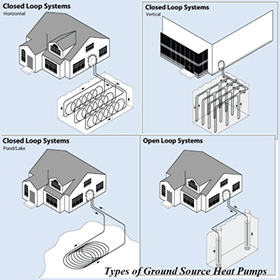Geothermal Heating & Cooling
GOING GREEN WITH GEOTHERMAL

Many of today's consumers are choosing technologies that allow them to be increasingly eco-friendly in their homes and personal environments. The earth itself is our home after all. By supporting its intricate life-sustaining systems as much as possible in our modern lifestyles, we are supporting ourselves.
One choice that some are making is the use of a geothermal energy system to heat and cool the home. While ground-source heating and cooling has been in use since the 1940's, it is now becoming more and more preferred as an alternate method to using some of earth's less sustainable energy sources.
Ground-source heating or cooling will either transfer heat from the earth's crust to the home, or transfer heat from the home through a system that releases it deep underground, leaving your home incredibly comfortable, eco-friendly, and energy-efficient.
Modern technology is learning to take advantage of geological characteristics that are as old as the earth itself. Our planet is an amazing source of heat. As the earth's crust remains in constant motion, massive amounts of energy are created and released in the form of heat or moisture. In addition, the crust maintains a near-constant ground temperature all year long, regardless of season, somewhere in the 50-60 degree F range. It also stores nearly fifty percent of the solar energy that reaches us. By taking advantage of the plentiful and completely renewable clean energy that is literally right under our feet, we can create comfortable homes and businesses that are as friendly to the environment as they are to our long-term budget.
THE GEOTHERMAL CYCLE
FOR HEAT – Simply put, energy from the ground itself deep under your home is retrieved and transferred into your home by means of a geothermal heat pump. The pump is installed on the surface of the ground, next to your home. A system of pipes running deep underground is attached to the heat pump.
Water or refrigerant is pumped through this system of pipes. As the water/refrigerant passes through geothermal energy pockets, it collects heat. The water is piped back to the surface, where an electrically-operated heat exchange system extracts the collected heat energy, and pushes it into your home in the form of heated air. The water/refrigerant now becomes much cooler, and is returned underground to collect more heat.
While this process still requires electricity to operate, heat is simply transferred from one place to another, without the need of an energy source to create it; therefore it uses much less electricity to operate than other heating and cooling systems. This more eco-friendly system of conditioning your home can last for years with little to no maintenance.
FOR COOL – The same system that can efficiently heat your home in the winter can just as effectively cool it during warmer months of the year. By reversing the heating process to operate in the same way that your kitchen refrigerator removes heat from your food, the system will remove the heat from your home and carry it underground to be released.
Your refrigerator's cycle continually absorbs, transports, and relocates heat away from its interior. The more heat it removes, the colder the internal temperature becomes. During warm weather months, by reversing its cold-weather operation, your geothermal heat pump will absorb heat from your home, remove it, and release it, leaving the air inside cooled and comfortable. This process has been proven to provide cooling twice as efficiently as any other cooling system.
CHOOSING MODEL COMFORT
Geothermal heating and cooling systems are available in a range of designs and models. You will need to ascertain whether a closed-loop, open-loop, or a pond/lake system will best serve your particular area.
Some geothermal heat pumps are equipped to supply hot water to the home, as well as heat. Systems are available with two-speed compressors and variable fans for more comfort and energy savings.
These systems tend to be quiet, longer-lasting with less maintenance, and are not affected by outside air temperatures. Some life estimations for a geothermal system are 25 years for internal components and as long as 50 years for your underground loop system.
It has been estimated that homeowners using a geothermal energy system can expect to save anywhere from 30% to as much as 75% on their annual heating and cooling costs. While it is currently a higher cost system to implement initially, many consider the significant energy savings over the following years to be well worth their initial investment.
If you would like to learn more about geothermal systems and determine if one might be right for you, please contact us by phone at 314-849-7900, or through this website.

